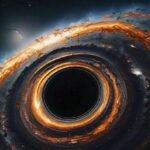What Is an Event Horizon? The Point of No Return
The crucial boundary surrounding a black hole, where escape velocity exceeds the speed of light, is known as the event horizon. Beyond this threshold, the black hole becomes invisible because gravity is so strong that no information, not even light, can escape.
Simplified Physics: The mass of the black hole determines the event horizon’s size, which is determined by the Schwarzschild radius. The horizons of larger black holes are also larger.
Astrophysical Significance: Einstein’s general theory of relativity predicts time dilation and twisted space-time at the event horizon, which provides a window into extreme physics.
Observation Methods: Tools such as the Event Horizon Telescope (EHT) have produced photos of the shadow a black hole’s event horizon casts, offering revolutionary visual evidence of these mysterious formations.
Spaghettification: The Gruesome Fate of Falling In
Spaghettification is the dramatic and terrible end that awaits objects that approach a black hole. The object is stretched into a thin, noodle-like shape by the differential in gravitational pull between its closer and further portions.
Scientific explanation: Tidal forces close to the event horizon of stellar-mass black holes are so strong that they tear apart anything before they can cross it. Supermassive black holes, on the other hand, have softer gradients, which enable things to pass through the horizon undamaged before being stretched.
Pop Culture Comparison: Imagine someone plunging headfirst into a black hole; the gravitational pull on their feet would be far greater than that on their head, causing them to elongate in a deadly, spectacular manner.
The Accretion Disk: A Black Hole’s Fiery Halo
As matter spirals into a black hole, it heats up from friction and releases powerful radiation, forming an accretion disk. These disks provide indirect evidence of black holes and are some of the universe’s brightest objects.
Formation Process: A spinning disk is created as gas, dust, and other materials are drawn in by a black hole’s gravity. Particles heat up to millions of degrees as they collide, releasing visible light and X-rays.
Astronomical Observations: Astronomers can determine the mass and spin of a black hole by examining the light spectra that accretion disks emit.
Relationship to Quasars: Some of the brightest and most distant objects ever seen in space are quasars, which are powered by supermassive black holes with active accretion.
Photon Rings and Gravitational Lensing: Light’s Last Dance
When light circles a black hole several times before leaving, photon rings are created. The amazing distortion of space-time brought about by black holes is visible in these rings.
How It Operates: Because of their tremendous gravity, black holes distort light trajectories. Around the black hole, photons form rings that resemble a luminous halo as they orbit at exact distances.
Lensing due to gravity: Images of background objects, such as galaxies, are magnified and distorted by this phenomenon. Lensing observations have contributed to the cosmic-scale validation of Einstein’s general relativity.
Use in Science: Researching photon rings can help us better comprehend these mysterious events by revealing a black hole’s mass, spin, and even its surrounding surroundings.
Beyond the Horizon: Do Wormholes or New Realms Exist?
There are intriguing questions concerning what might be beyond the event horizon. Theories cover anything from hypothetical routes like wormholes to singularities.
Singularities: Density and gravity become infinite at the singularity, which is the center of the black hole, shattering our existing understanding of physics.
Wormholes: Although there is currently no proof, some speculative models propose that black holes could use wormholes to connect to other regions of the universe or perhaps other universes.
Quantum Theories: Researchers like Stephen Hawking have challenged the idea that “nothing escaping” occurs by putting out ideas like Hawking radiation, in which black holes progressively shed mass.









